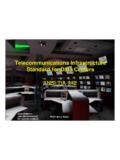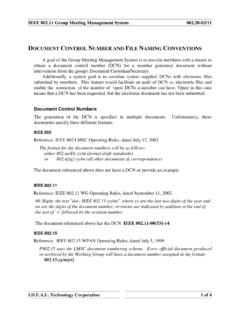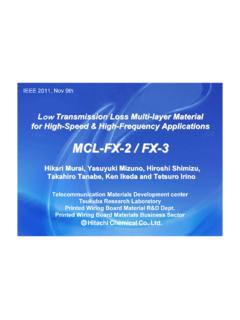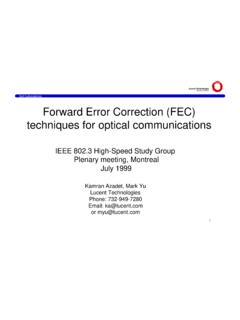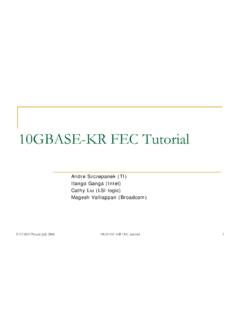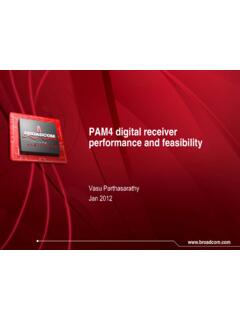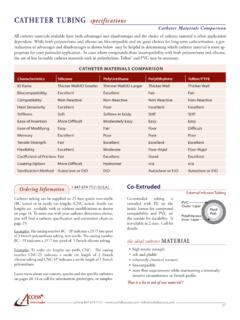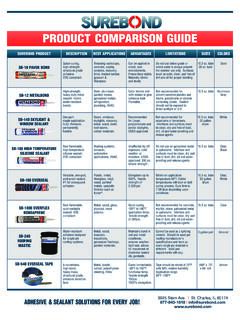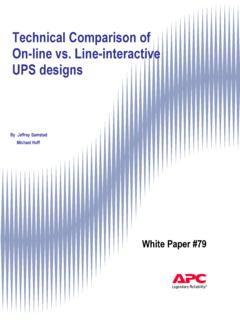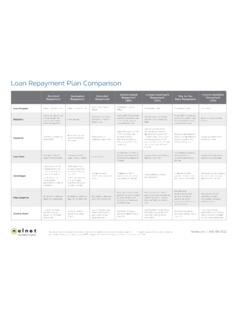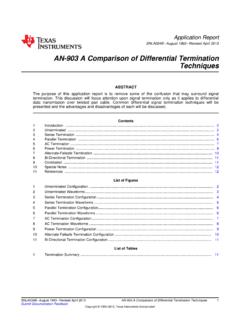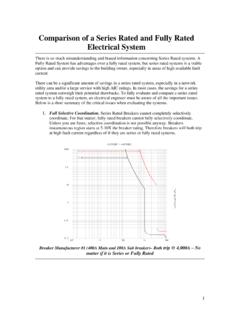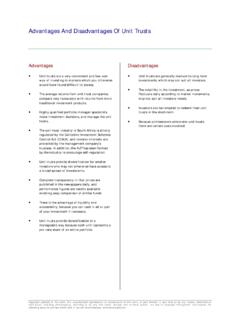Transcription of Comparison of PAM-4 and NRZ Signaling - IEEE 802
1 Comparison of PAM-4 and NRZ Signaling March 10, 2004 David R Stauffer, , Stephen D. Anderson, Anthony Sanders, Alex Deas, , and Bhavesh Bhakta R Stauffer, is the Chair of the UXPi [1] Technical Council, and is a Senior Engineer with IBM Microelectronics. Stephen D. Anderson is the UXPi editor, and is a Staff Engineer with Xilinx, Inc. Communications Technology Division. Anthony Sanders is a Principle Engineer with Infineon Deas, is a member of the staff of Acuid Bhakta is a member of the technical staff with Texas Instruments. and PerceptionNRZ is the incumbent Signaling method for 3 Gbps and 6 Gbps generations of electrical solution for 10-12 Gbps generations of standards currently being investigated. Factors include:Complexity of silicon (equalization, signalling method)Complexity of channel design (backplane, connectors)Market is fragmented into vendors assuming Greenfield channels and vendors that want to use legacy dissapation (of silicon -- but higher loss channels will require more power dissapation in silicon) and PerceptionPopular perception is that PAM-4 signalling enables use of legacy backplanes and interconnect.
2 More detailed analysis of NRZ and PAM-4 signalling methods shows that reality is more complex: PAM-4 does not universally guarantee that legacy backplane designs will be is not universally excluded from serving legacy designs. of ComparisonNRZ and PAM-4 are compared on the following points:Vertical Eye Opening (Differential Amplitude)Horizontal Eye Closure (Unit Interval minus Jitter)Crosstalk Budget (Difference between amplitude of Noise Aggressor and Signal of Noise Victim)Power Analysis Eye Opening ComparisonPAM-4 vs. NRZ factors effecting vertical eye opening:Channel loss rises with frequencyLower baud rate of PAM-4 implies less loss in channelPAM-4 launch amplitude per signal level is 33% of NRZ for equivalent driver technology and supply voltageAt lower frequencies: Higher launch for NRZ provides greater vertical eye higher frequencies: Lower loss for PAM-4 (because baud rate is 1/2 that of NRZ) compensates for lower launch voltage and results in greater vertical eye opening.
3 Opening for NRZ(red) and 4 PAM(blue) vs. equivalent data rate for 26" transmission line. (Source: Acuid Corporation)Vertical Eye Opening ComparisonTransmission line analysis shows expected crossover above 35 results in bigger eye below crossover (range of current interest) PAM-4 results in bigger eye above crossover Implementation NotesPrevious Comparison assumes similar silicon technologies and power supply voltages for the NRZ and PAM-4 existing PAM-4 implementations use higher power supply voltages to increase the total available dynamic range. Advantages:Increased transmit eye amplitudeDisadvantages:Increased power dissapationMay require use of dual-oxide devices in silicon implementationNote: NRZ can also increase transmit amplitude to enable operation on lossy channels.
4 Eye Opening ComparisonPAM-4 vs. NRZ factors effecting horizontal eye opening:Lower baud rate means more eye width due to base at the transmitter are related to spectrum of the transmitted signal and tend to scale with baud that absolute value of DJ/RJ for half baud rate design would be 2x that of full baud rate careful design should be able to achieve DJ/RJ for half baud rate design of that of full baud rate cycle minus DJ/RJ still results in larger horizontal eye opening for PAM-4 .. if these were the only factors .. Eye Opening ComparisonPAM-4 vs. NRZ factors effecting horizontal eye opening: PAM-4 results in additional loss in 33% of eye width due to switching between adjacent and non-adjacent levels. Eye Opening ComparisonPAM-4 vs.
5 NRZ factors effecting horizontal eye opening:Combination of effects will result in larger horizontal eye opening for a PAM-4 solution at transmitter eye opening for PAM-4 is not twice as large as NRZ as would be implied from baud rate difference. NRZPAM-4 Total Cycle ( Gbps)90 ps180 psTotal Jitter ( UI) 27 ps ( UI) 48 psLoss in Eye Width for PAM-4 0 ps( UI) 60 psEye Opening at Tx( UI) 63 ps( UI) 72 ps Eye Opening ComparisonPAM-4 vs. NRZ factors effecting horizontal eye opening:Eye width reduction at Transmitter due to PAM-4 switching between adjacent and non-adjacent levels is effectively a form of deterministic of this jitter component is near the frequency of the baud rate, substantially above the bandwidth of the jitter with this spectrum is particularly susceptible to phase noise amplification by the channel.
6 Implementation NotesPrevious Comparison assumes no special encoding of data to overcome limitations of signalling existing PAM-4 implementations use coding to limit or eliminate transitions between non-adjacent :Increased eye width due to reduction/elimination of non-adjacent transition :Coding requires overhead (~25% typical) and thereby requires higher baud rate to achieve same bit rate. For 25% overhead, net improvement in eye width is ~ : NRZ can also increase use coding to set minimum run length to control spectral content of signal and thereby reduce frequency dependent losses in channel. ConcernsCrosstalk is a substantial contributor to jitter at the maximum signal swing is similar to NRZ and therefore the noise level from the aggressor signal is the same for both PAM-4 and vertical eye opening is 33% of NRZ and therefore the victim signal's tolerance for crosstalk is budget for PAM-4 therefore starts out 9 dB less than for channel attenuation at higher frequencies reduces this advantage for NRZ to the 3-6 dB range (depending on channel design).
7 ConcernsPower analysis is based on implementation experience in TSMC um and um provides power savings for Tx/Rx circuits over NRZ:3:1 ratio of PAM-4 Tx/Rx circuits to NRZ Tx/Rx circuitsEach circuit operates at 1/2 baud rate and uses 1/3 the power (average dependent on circuit design)Net is PAM-4 Tx/Rx uses same power as NRZ Tx/RxAssumes equivalent power suppliesAssumes equivalent power utilization by equalization circuits ConcernsPAM-4 systems generally use larger power supply voltages to overcome vertical eye in launch amplitude results in power dissapation increase (placing PAM-4 at a power disadvantage).To achieve equivalent power dissapation, less complex equalization scheme must be assumed for equalization schemes require significant increase in power dissapation for PAM-4 vs.
8 NRZ due to implementation complexity (placing PAM-4 at a power disadvantage). PAM-4 with DFE is also undesirable due to DFE error propagation used to improve performance of PAM-4 carry significant power penalities, negating any power advantage of PAM-4 . Eye AnalysisStatistical Eye Analysis technique is described in [2].Algorithm uses S-parameter measurements of a channel along with ideal transmitter and receiver models to determine whether the channel can pass a receivable signal. Algorithm selects optimal coefficients for transmit pre-emphasis and the receiver filter, and then uses statistical techniques to determine the resulting eye opening after receiver equalization. Eye Analysis (Assumptions)Goal of this analysis is to compare an NRZ solution to a PAM-4 solution of approximately equivalent complexity and power analysis using 5 backplanes:Four backplanes are existing backplanes from various companies designed for 10 Gbps legacy backplane (backplane E).
9 Equalization assumptions (based on existing best-of-breed for each signalling technique):NRZ with preemphasis and 4-tap DFE PAM-4 with linear equalizationSimilar supply voltage for both NRZ and PAM-4 drivers is assumed ( signal swing for each PAM-4 signal level is 33% of NRZ case). Eye Analysis (Pass/Fail Criteria)Analysis performed for 1 to 6 crosstalk / Fail Criteria:Amplitude is open if > VJitter is okay if < UINRZ and PAM-4 cases can be compared by determining number of crosstalk aggressors at which one or both of the pass/fail criteria indicate failure. A ResultsNRZ Eye:Vertical Eye is Openfor < 2 aggressorsHorizontal Eye is okayfor < 1 aggressorsPAM4 Eye:Closed123456 Number of Opening AmplitudeNRZPAM4 Vertical Eye123456 Number of Closure JitterNRZPAM4 Horizontal Eye B ResultsNRZ Eye:Vertical Eye is OpenHorizontal Eye is okayfor < 2 aggressorsPAM4 Eye:Closed123456 Number of Opening AmplitudeNRZPAM4 Vertical Eye123456 Number of Closure JitterNRZPAM4 Horizontal Eye C ResultsNRZ Eye:Vertical Eye is OpenHorizontal Eye is okayPAM4 Eye:Closed123456 Number of Opening AmplitudeNRZPAM4 Vertical Eye123456 Number of Closure JitterNRZPAM4 Horizontal Eye D ResultsNRZ Eye:Vertical Eye is Openfor < 3 aggressorsHorizontal Eye is okayfor < 2 aggressorsPAM4 Eye.
10 Closed123456 Number of Opening AmplitudeNRZPAM4 Vertical Eye123456 Number of Closure JitterNRZPAM4 Horizontal Eye E (Legacy Case) Results123456 Number of Opening AmplitudeNRZPAM4 Vertical Eye123456 Number of Closure JitterNRZPAM4 Horizontal EyeNRZ Eye:ClosedPAM4 Eye:Closed does not have a demonstrated performance advantage over NRZ for this set of is not a magic bullet to achieve legacy support. PAM-4 will perform better or worse than NRZ based on channel design factors. The results show NRZ performed better for the five backplanes being A, B, C, and D passed NRZ with at least 1 aggressor and all of these failed to pass PAM-4 even with 0 C passes NRZ with 6 aggressors, but fails to pass PAM-4 even for 0 Backplane E failed to pass NRZ; it also failed to pass PAM-4 .
